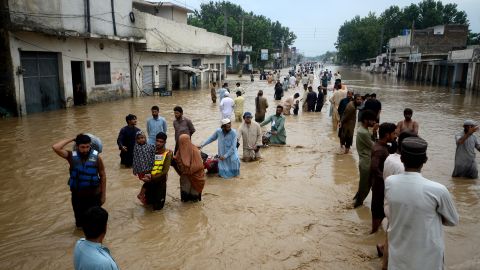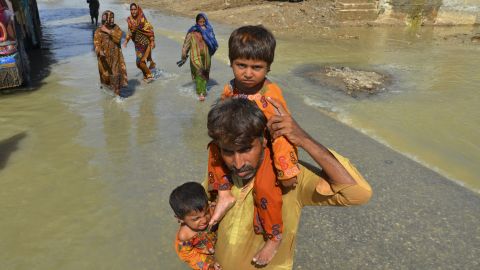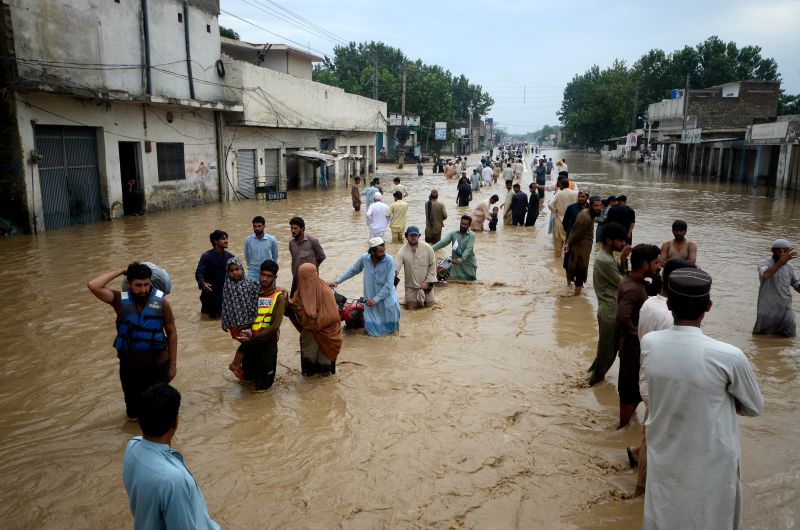CNN
—
Severe rains and flooding have killed at least 1,033 people, including 348 children, and left 1,527 more injured in Pakistan since mid-June, officials said on Sunday.
The country’s National Disaster Management Authority (NDMA) added that 119 people had died and 71 injured in the last 24 hours alone.
At least 33 million people have been affected by the disaster, Pakistan’s Minister for Climate Change Sherry Rehman said on Thursday. She called the floods “unprecedented” and “the worst humanitarian disaster of this decade.”
“Pakistan is going through its eighth cycle of monsoon while normally the country has only three to four cycles of rain,” Rehman said. “The percentages of super flood torrents are shocking.”
She highlighted in particular the impact on the south of the country, adding that “maximum” relief efforts are underway.

The deployment of the army was authorized to assist with relief and rescue operations in flood-stricken areas, the country’s Ministry of Interior said in a statement on Friday.
The ministry said troops would assist Pakistan’s four provincial governments, including the worst-hit southwestern province of Balochistan.
The exact number of troops as well as where and when they would be deployed would be worked out between the provinces and the government, the ministry said.
Meanwhile, flood relief centers are being established in various parts of the country to assist collection, transportation and distribution of flood relief goods to victims, the Pakistan Armed Forces said.
Army troops are also helping people evacuate to safer places, providing shelter, meals and providing medical care to those affected by the floods, the armed forces said.
The southern province of Sindh, which has been badly hit by the flooding, has asked for 1 million tents, while nearby Balochistan province – largely cut off from electricity, gas and the internet – has requested 100,000 tents, Rehman said.
“Pakistan’s priority, at the moment, is this climate-induced humanitarian disaster of epic proportions,” Rehman said, urging the international community to provide aid given Pakistan’s “limited” resources.


On Friday, Pakistan’s Prime Minister Sharif briefed international diplomats on the crisis, stating that his country – on the front line of climate change despite a relatively small carbon footprint – must focus its rehabilitation toward greater climate change resilience.
Minister for Planning and Development Ahsan Iqbal separately told Reuters that 30 million people had been affected, a figure that would represent about 15% of the South Asian country’s population.
UN agency Office for the Coordination of Humanitarian Affairs (OCHA) said in an update on Thursday that the monsoon rains had affected some 3 million people in Pakistan, of whom 184,000 have been displaced to relief camps across the country.
Funding and reconstruction efforts will be a challenge for cash-strapped Pakistan, which is having to cut spending to ensure that the International Monetary Fund approves the release of much-needed bailout money.
The NDMA said in a report that in the past 24 hours, 150 kilometers (about 93 miles) of roads had been damaged across the country and more than 82,000 homes partially or fully damaged.
Since mid-June, when the monsoon began, more than 3,000 kilometers (1,864 miles) of road, 130 bridges and 495,000 homes have been damaged, according to NDMA’s last situation report, figures also echoed in the OHCA report.

